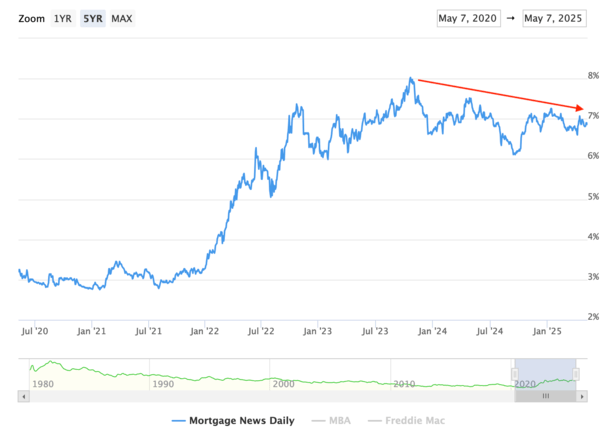I got to thinking lately that mortgage rates are probably as good as they’re going to be for the foreseeable future.
And by that, I mean until at least August, as there’s just too much up in the air at the moment.
We’ve got the ongoing trade war and tariffs, along with an upcoming spending bill to deal with.
So even if we make some headway on trade talks, there’s that bill to worry about next.
It’s almost like getting past one wave, only to look up and see another come crashing down on you.
You Might Need to Adjust Your Mortgage Rate Expectations

While I’ve argued that we’ve been in a falling mortgage rate environment for a while now, it’s not without its ebbs and flows.
Really, since October 2023, the 30-year fixed has been drifting lower. Back then it hit a cycle high of about 8%.
And since then, it’s been significantly lower, though still markedly higher than the 3% rates we were all accustomed to seeing in 2022 and earlier.
Sure, there have been better and worse periods for mortgage rates over the past 18 months, but the general trend over time has been lower.
If you zoom out, as I have in the chart above from Mortgage News Daily, you’ll see that trend lower.
You’ll also see that mortgage rates were a lot lower last summer. But that was before President Trump came into office.
With both the tariffs and a major spending bill on the table, mortgage rates might be stuck for a while as their effects remain to be seen.
The Fed just echoed this sentiment in its latest FOMC statement, saying “the risks of higher unemployment and higher inflation have risen.”
That makes it difficult to make any big decisions until there’s more clarity, not that the Fed controls mortgage rates directly anyway.
The Big, Beautiful Bill Is the Other Elephant in the Room
Now assuming we make headway on the trade war situation and get some sort of resolution with China, it might feel like we’re in the clear.
That we can maybe get back to those low-6% mortgage rates that don’t look half-bad anymore.
But wait, there’s more! Another big objective the new administration is working on is a sweeping government spending bill.
A bill dubbed the “big, beautiful bill,” that many expect will greatly increase government debt issuance.
Simply put, more bonds, higher yields, all else equal, in order to bring in buyers. And higher yields mean higher interest rates.
So that’s yet another headwind facing mortgage rates in their fight to move lower.
That bill is expected to be sorted out around early July, but likely won’t come without lots of drama.
In the meantime, this will likely make it difficult for mortgage rates to make any big moves lower.
So even if the trade situation gets resolved and comes out great, somehow, we’ve still got upward pressure.
The good news is it too might be resolved by around the start of the third quarter. So if you’re patient, things could get better in the second half of the year.
If You Believe Rates Will Eventually Be Lower, You Can Maybe Refi Later
I hesitate to even suggest a buy now, refinance later approach, given how wrong it was for the past several years.
When mortgage rates first went up in 2022, real estate agents and loan officers were saying to marry the house, date the rate.
They assumed the uptick in mortgage rates would be temporary. It turned out not to be. Not even close.
It’s now been about three years since the 30-year fixed was hovering around 3%. And getting anywhere close to that seems highly unlikely.
Heck, even getting back into the 5s feels like a challenge. But given we’ve been stuck in a higher range for nearly three years now, the argument might be a little more realistic.
With rates quite elevated today, the chances of them going lower has increased. After all, it’s easier to drop from 7% to 6% than it is to go from 3% to 7% and back to 4%.
But again, trying to time the market or predict mortgage rates is often a fool’s errand.
Still, I’m optimistic that the second half will be better for mortgage rates. Once we get these two big issues behind us.
For the record, these big issues could also cool the economy, lead to higher unemployment, and by nature, lower mortgage rates.
Not ideal, but it might be the outcome. Just make sure you can actually qualify for a mortgage refinance if that’s your plan.
You’ll still need steady employment, sufficient income, and good credit to get approved.
Read on: 2025 mortgage rate predictions

